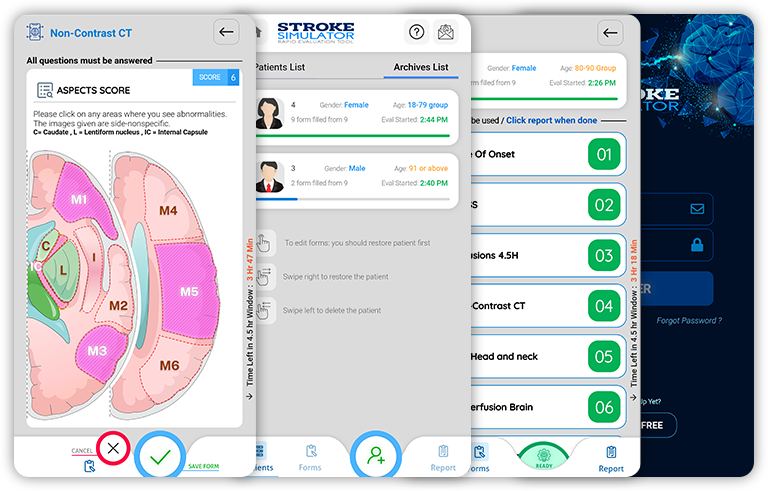
The basic operating principle of the STROKE SIMULATOR app is to quickly and systematically obtain all the information that coulde be of relevance in determining the following
- Is the patient a candidate for IV TPA admininstration in the 4.5 hr window
- Is the patient a candidate for Endovascular intervertion in the 6 hour window
- Is the patient a candidate for endovascular intervention under DEFUSE 3 criteria within the 6-16 hr window
- Is the patient a candidate for endovascular intervention under DAWN criteria within teh 6-24 hr window
Data input has been arranged in a way that is fast, easy and intuitive. This starts with entering the time of onset, a rapid NIHSS scoring system, a comprehensive Yes/No list of exclusions that puts minimal demands on the user's memory or mastery of the list of exclusions. The non-contrast CT scan tab features a clickable image that instantly computes the ASPECTS score, and quickly goes through a Yes/No list of abnormalities that essentially round up any abnormalities that could be of relevance in one or more of the 4 sets of criteria listed above for IV or endovascular intervention. The CTA tab and the CT Perfusion tab are simple and easy, yet round up all of those specific abnormalities that are of of relevance when deciding whether the patient is an endovascular candidate , depending on the elapsed time. The EKG/Labs /PHx tab focuses on a few points that could either support or negate the final decision. A modified Ranklin scale that takes only a few seconds to administer has been incorporated. And last but not the least the risk/benefit tab computes the risk based on the HAT score and also inputs the life expectancy question which is of relevance is some situations.
Tapping the 'REPORT' button brings up a compilation of all data supplied thus far, and offers a pink 'ANALYSE' button, which on tapping brings up the final analysis and suggestions.
The ANALYSIS AND SUGGESTION section is the last part of the process, and it systematically addresses the four sets of criteria that are used for determining if the patient is a candidate for IV TPA or endovascular intervention. And all this is done seamlessly without the chaos or time consuming , google searching , second guessing, 'do I go out on a limb now or not' process that often characterizes the stroke code.
Initially the app processes the criteria for the 4.5 hr window for IV TPA, and analyses the NIHSS score, time of onset, ASPECT score, CT findings, BP, Glucose, systemic exam findings, and the entire list of exclusions. If the patient is not a candidate the app clearly states WHY the patient is not a candidate. This is a crucial and powerful feature, whereby you get to hold the app accountable instantly for what it says. So it is not the YES or NO, but the WHY that makes this app a powerful tool for the ER, for an entire range of health care providers with varying levels of training, experience and expertise.
Next the app processes criteria for the 6 hr endovascular intervention window. The NIHSS score, ASPECT score, CT findings, CTA findings, The Modified Ranklin score and the elapsed time are used as data to compute and give a YES or NO response, and if the response is NO, clear reasons are given as to WHY.
Third comes the DEFUSE 3 criteria, designed to determine if the patient is an endovascular candidate in the 6- 16 hour window. The app factors in the patient's age, elapsed time, Ranklin score, NIHSS score, CT ASPECTS score, CTA findings, CT Perfusion findings, CT brain findings, and a large list of exclusionary criteria to make a decision. If any of the required data points are missing, it will say so and give the user the opportunity to go back into the input tabs and enter the missing data. And finally it will give an YES or NO answer, and if the answer is NO, there will be a list of reasons as to WHY. This helps a lot when you are discussing the patient's care with other providers or with family , you have clear talking points to justify your decision.
And finally we get to the DAWN criteria used to determine the appropriateness of endovascular intervention in the 6-24 hour window, which is a complex decision making process that takes into account the age NIHSS score, CTA findings, Core infarct size, CT findings, and the modified Ranklin score.
The strength of the Stroke Simulator app is the transparency of the process, where you see in front of you all the data that has been analyzed, any data that is missing , the decisions, and the rationale behind the decision.
And finally the entire ANALYSIS AND SUGGESTIONS is exportable as a PDF file that you can share with colleagues by email or bluetooth or other sharing apps, or you can simply print it out using your wireless printer. The app takes care to avoid any identifiable patient information and hence safe under HIPAA and other patient confidentiality rules. Rather it uses the name of the doctor, the patient initials, age, and time of the encounter to help you keep track.
STROKE SIMULATOR is available for Android and iOS (Apple) devices.
The producers of STROKE SIMULATOR encourage you to send in any and all suggestions for improvement and we will strive to include those in the next version.
